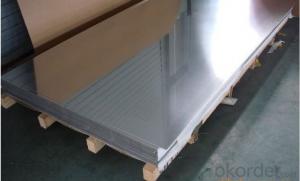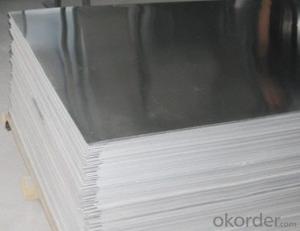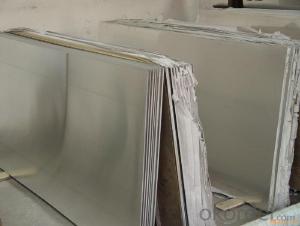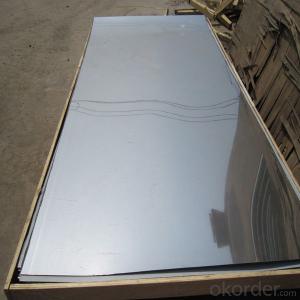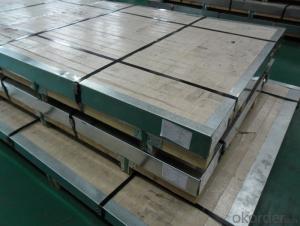Stainless Steel Plate 316 with No.4 Surface Treatment
- Loading Port:
- Shanghai
- Payment Terms:
- TT OR LC
- Min Order Qty:
- 500 m.t.
- Supply Capability:
- 5000000 m.t./month
OKorder Service Pledge
OKorder Financial Service
You Might Also Like
Hot sale stainless steel sheet 201/202/304/304l/310S/309S/316L/316Ti/316/316l/321,410/420/430/444/443/409L, and 904L.
Description of Stainless Steel Sheet:
Description | steel sheet,hot rolled steel sheet,cold rolled steel sheet, steel sheet,sheet,steel plate |
Standard | ASME, ASTM, EN ,BS,GB,DIN, JIS etc |
Application | Steel sheet applies to construction field, ships building industry, petroleum & chemical industries, war and electricity industries, food processing and medical industry, boiler heat exchanger, machinery and hardware fields. |
Packaging | Standard export sea-worthy packing |
Delivery time | 10-30 days |
Quality | No.1 |
Productivity | 500 tons/Day |
Note | Our company has cooperative relation between the domestic agents. Stainless steel sheet can be made accordingto the customers requirements. Fasten delivery. Quality assured. |
Contacts | If you have any question,please feel free contact me. |
Stainless steel sheet surface finish characteristics
Surface finish | Characteristics and application |
2B | The surface brightness and flatness of no2B is better than no2D. then through a special surface treatment to improve its mechanical properties,No2B could nearly satisfy comprehensive uses. |
No.1 | Polished with abrasive belt of grit#100-#200, have better brightness with discontinuous coarse stria, used as inner and external ornaments for building, electrical appliances and kitchen utensils etc. |
No.4 | Polished with abrasive belt of grit #150-#180,have better brightness with discontinuous coarse stria, but thinner than No3, are used as bathtub buildings inner and external ornaments electrical appliances kitchen utensils and food processing equipment etc. |
HL | Polished with abrasive belt of grit #150-#320 on the NO.4 finish and has continuous streaks, mainly used as buildings ornaments elevators, door of building, frontal plate etc. |
BA | Cold rolled, bright annealed and skin-passed, the product have excellent brightness and good reflexivity like mirror, kitchen apparatus, ornament etc. |
8K | The product have excellent brightness and prefer reflexivity can to be the mirror. |
Main Features of stainless steel sheet :
•Escalator, Elevator, Doors
•Furniture
•Production tools, Kitchen appliances, freezers, cold rooms
•Auto Parts
•Machinery and Packaging
•Equipment and Medical devices
•Transport system
Product Details:
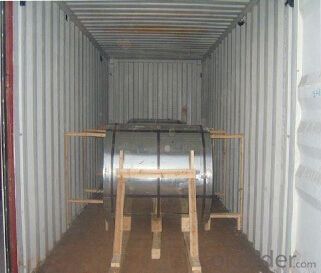
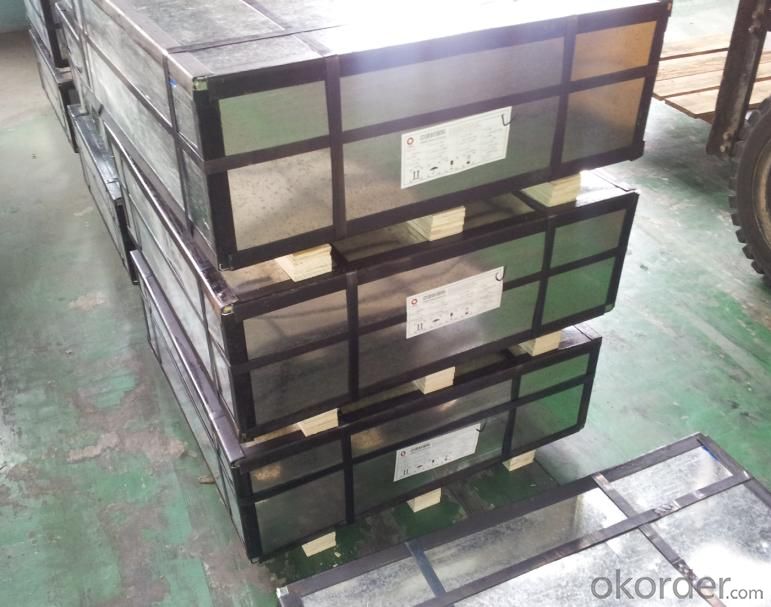
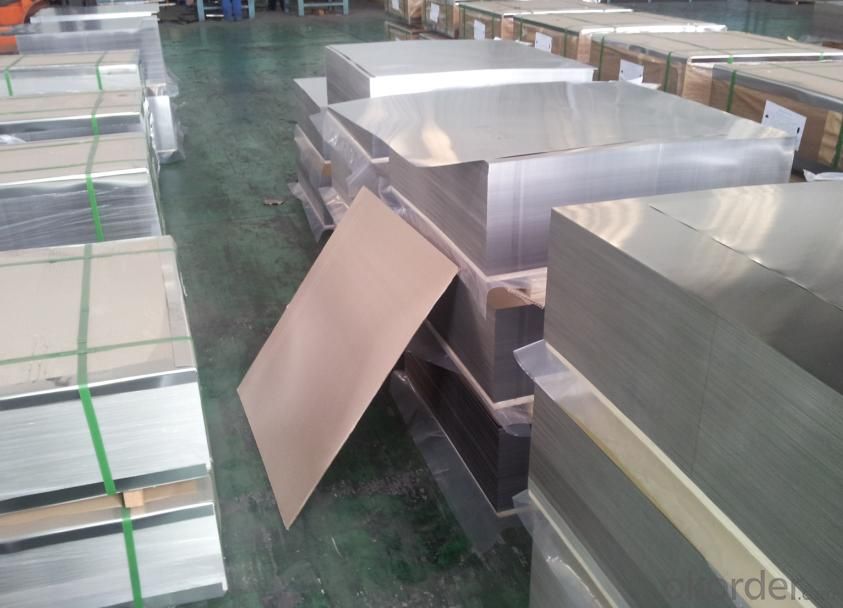
Sandard Seaworth Packing(wooden packing with water proof paper)
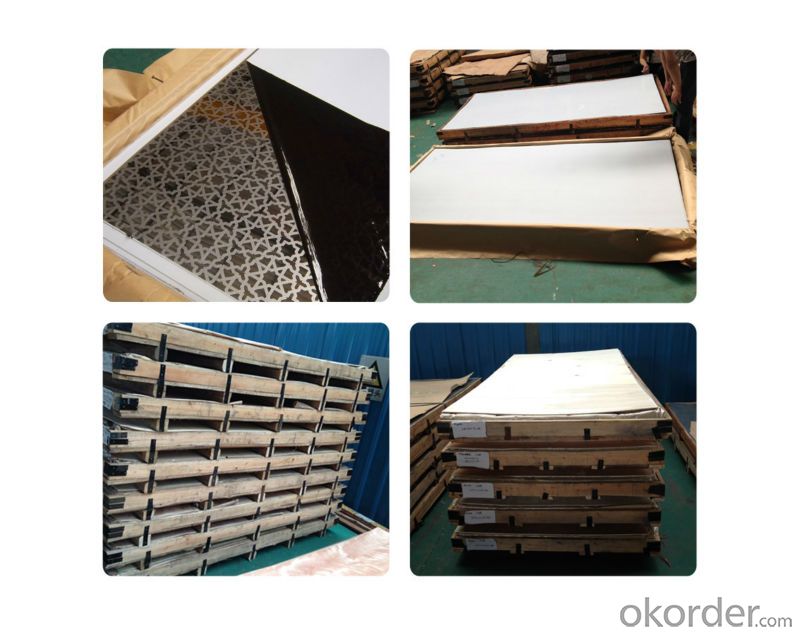
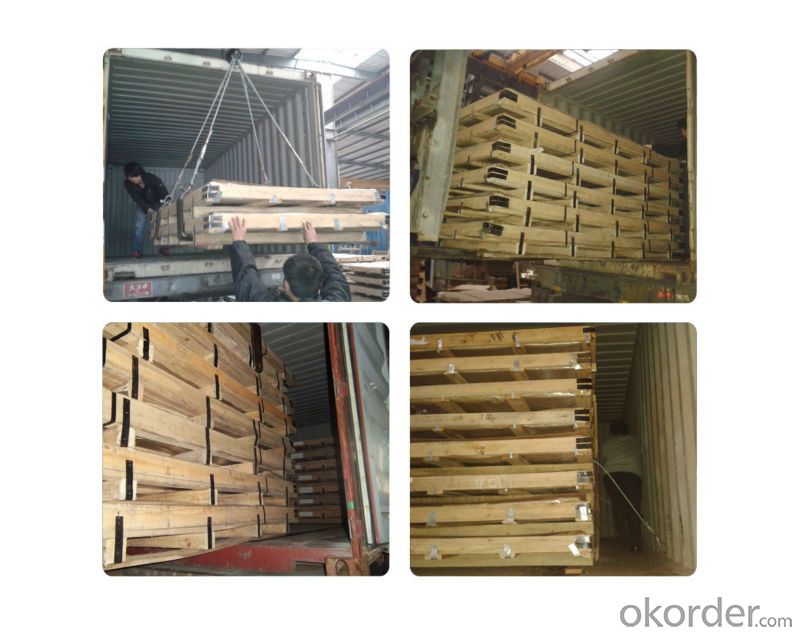
FAQ:
1. What's the quality?
very fine
2. How long get reply?
within 24 hours
If you have any question about stainless steel sheets,donot forget to sending the email to Us! You will get the competitive Price and have a very good experience about the Buying Process! CNBM International Corporation is always your trustful friend!
- Q:What are the different types of stainless steel sheet perforations available?
- There exists a variety of stainless steel sheet perforations, each possessing its own distinctive characteristics and applications. Among the most prevalent types are: 1. Round hole perforations: These perforations, characterized by evenly spaced round holes, are the simplest and most commonly employed. They ensure sufficient airflow and visibility. 2. Square hole perforations: Similar to their round counterparts, square hole perforations offer a distinct aesthetic and may be utilized for ventilation or decorative purposes. 3. Slotted perforations: Elongated in shape, slotted holes provide a larger open area compared to round or square holes. Consequently, they are often employed for drainage or filtering applications. 4. Hexagonal hole perforations: Hexagonal holes, featuring an exclusive pattern, are frequently used for architectural or decorative applications. They are also effective in facilitating airflow and visibility. 5. Decorative perforations: These perforations exhibit diverse shapes and designs, such as floral, geometric, or abstract patterns. Primarily employed for decorative purposes, they are commonly found in building facades or interior design. 6. Micro-perforations: These minute holes, typically less than 1mm in diameter, are utilized in applications necessitating high precision and fine filtration, like speaker grills or air diffusers. When selecting the appropriate perforation type, it is crucial to consider the specific requirements of your application. Factors such as open area, strength, visibility, and aesthetics must all be carefully evaluated to guarantee the most suitable choice for your specific needs.
- Q:What are the different thickness tolerances for stainless steel sheets?
- There are various thickness tolerances for stainless steel sheets depending on the specific grade and industry standards. Generally, the thickness tolerances for stainless steel sheets can range from ±0.0015 inches to ±0.030 inches, with tighter tolerances being more common for precision applications.
- Q:How do stainless steel sheets differ from regular steel sheets?
- Stainless steel sheets differ from regular steel sheets in several key aspects. Firstly, stainless steel is an alloy that contains a minimum of 10.5% chromium by mass. This chromium content forms a protective passive layer on the surface of the steel, which helps to prevent corrosion and staining. In contrast, regular steel sheets are prone to rusting and corrosion when exposed to moisture or certain chemicals. Secondly, stainless steel sheets have a higher resistance to heat and oxidation compared to regular steel sheets. This makes stainless steel an ideal choice for applications that require high temperature resistance, such as industrial furnaces or automotive exhaust systems. Thirdly, stainless steel sheets possess excellent strength and durability, making them suitable for various structural and industrial applications. Regular steel sheets may have lower strength and durability, depending on their composition and manufacturing process. Additionally, stainless steel sheets have an attractive appearance due to their smooth and shiny surface. This aesthetic quality makes stainless steel sheets a popular choice in architectural, interior design, and decorative applications. Lastly, stainless steel sheets are known for their hygienic properties, as they are non-porous and easy to clean. This makes them commonly used in industries with strict hygiene requirements, such as food processing, pharmaceuticals, and healthcare. Overall, the major differences between stainless steel sheets and regular steel sheets lie in their corrosion resistance, heat resistance, strength, appearance, and hygiene properties. These unique characteristics make stainless steel sheets a preferred material for many industries and applications.
- Q:How do you prevent warping of stainless steel sheets?
- To prevent warping of stainless steel sheets, there are several measures that can be taken: 1. Proper storage and handling: Stainless steel sheets should be stored in a clean and dry environment, away from any sources of moisture or excessive heat. It is important to handle the sheets with care, avoiding any unnecessary bending or pressure that could lead to warping. 2. Correct welding techniques: When welding stainless steel sheets, it is crucial to use the appropriate techniques and procedures. Proper heat control and weld placement can help minimize the risk of warping. Preheating the sheets before welding can also help prevent distortion. 3. Stress relieving: This process involves heating the stainless steel sheets to a specific temperature and then cooling them slowly. Stress relieving helps to eliminate residual stresses that could lead to warping. 4. Support during machining: When machining stainless steel sheets, it is important to provide proper support to prevent warping. This can be achieved by using clamps or fixtures to securely hold the sheets in place. 5. Minimize heat exposure: Excessive heat can cause stainless steel sheets to warp. Therefore, it is important to avoid prolonged exposure to high temperatures during processes such as cutting, grinding, or forming. Using coolants or lubricants during these processes can help dissipate heat and minimize the risk of warping. 6. Choosing the right grade and thickness: Selecting the appropriate grade and thickness of stainless steel sheets for a specific application is essential. Thicker sheets generally have more resistance to warping, while certain grades of stainless steel may be more prone to distortion. Consulting with a materials expert or engineer can help in selecting the right stainless steel sheets for a particular project. By implementing these preventive measures, the risk of warping stainless steel sheets can be significantly reduced, ensuring their integrity and longevity.
- Q:What are the different types of stainless steel sheet edges available?
- There are several different types of stainless steel sheet edges available, each offering its own unique advantages and characteristics. 1. Mill Edge: This is the standard edge finish produced during the manufacturing process. It has a straight, sharp edge with no additional treatment or finishing. Mill edge stainless steel sheets are commonly used in industrial applications where aesthetics are not a priority. 2. Slit Edge: Slit edge stainless steel sheets are created by cutting the sheet along its length, resulting in a slightly rounded edge. This type of edge is commonly used in applications where safety is a concern, as it reduces the risk of sharp edges causing injury. 3. Sheared Edge: Sheared edge stainless steel sheets are created by cutting the sheet along its width using shearing blades. This process produces a clean, straight edge without any additional finishing. Sheared edge sheets are often used in applications where precise dimensions are required. 4. Deburred Edge: Deburred edge stainless steel sheets have gone through a process to remove any sharp or rough edges, resulting in a smooth and safe edge finish. Deburring is often done using abrasive materials or specialized machinery. These sheets are commonly used in applications where safety and aesthetic appearance are both important. 5. Rolled Edge: Rolled edge stainless steel sheets have a curved or rounded edge, created by rolling the sheet during the manufacturing process. This edge type is commonly used in applications where a smoother, more finished appearance is desired. Rolled edge sheets are also easier to handle and less likely to cause injury during installation. Overall, the choice of stainless steel sheet edge depends on the specific requirements of the application, including safety concerns, aesthetic preferences, and dimensional accuracy.
- Q:Are stainless steel sheets resistant to hydrogen embrittlement?
- Stainless steel sheets are commonly resistant to hydrogen embrittlement. Hydrogen embrittlement refers to the brittleness and susceptibility to cracking caused by the diffusion of hydrogen atoms into the metal structure. Nonetheless, stainless steel has a strong resistance to hydrogen embrittlement due to its distinct composition and microstructure. The presence of chromium in stainless steel produces a protective oxide layer on the surface, acting as a barrier against hydrogen diffusion. Furthermore, stainless steel sheets are often alloyed with elements like nickel and molybdenum, further enhancing their resistance to hydrogen embrittlement. However, it is important to note that certain conditions, such as high temperatures or high levels of hydrogen exposure, can still potentially result in hydrogen embrittlement in stainless steel. Hence, it is crucial to consider the specific application and operating conditions when determining the suitability of stainless steel sheets in relation to hydrogen embrittlement.
- Q:What are the different types of surface protection available for stainless steel sheets?
- There are several types of surface protection available for stainless steel sheets, each designed to provide varying levels of protection against corrosion, scratches, and other forms of damage. 1. Protective film: This is a commonly used surface protection method, where a thin, adhesive film is applied to the stainless steel sheet. The film acts as a barrier, protecting the surface from scratches, dirt, and other contaminants. It is typically removed after installation. 2. PVC coating: Polyvinyl chloride (PVC) coating is another popular option for surface protection. It is a thicker, more durable layer that provides excellent corrosion resistance. PVC coatings come in various colors and finishes, and can be applied to stainless steel sheets through a process called powder coating. 3. Paint coating: Similar to PVC coating, paint coating involves applying a layer of paint to the stainless steel surface. This can be done through spray painting or electrostatic coating methods. Paint coatings not only protect against corrosion but also offer aesthetic enhancements. 4. Passivation: Passivation is a chemical process that removes iron from the stainless steel surface, creating a protective oxide layer. This layer improves the corrosion resistance of the stainless steel sheet. Passivation is commonly used in industries where the stainless steel is exposed to aggressive environments. 5. Electropolishing: Electropolishing is a process that removes a thin layer of metal from the stainless steel surface, resulting in a smooth and clean finish. This process not only enhances the appearance of the stainless steel but also improves its resistance to corrosion. 6. Metal plating: Metal plating involves applying a thin layer of another metal, such as zinc or nickel, onto the stainless steel surface. This provides sacrificial protection, as the plated metal corrodes instead of the underlying stainless steel. Metal plating is commonly used in outdoor applications where the stainless steel is exposed to harsh environments. It is important to choose the appropriate type of surface protection based on the specific requirements of the stainless steel sheet. Factors such as the environment, intended use, and aesthetic preferences should be considered when selecting the most suitable surface protection method.
- Q:What is the impact strength of stainless steel sheets?
- The impact strength of stainless steel sheets is relatively high compared to other materials, making them resistant to cracks and fractures when subjected to sudden forces or impacts.
- Q:What are the different types of stainless steel sheet finishes for decorative purposes?
- For decorative purposes, there are several different types of finishes commonly used on stainless steel sheets. These finishes are achieved through various surface treatments and processes, resulting in distinct appearances and textures. Some of the popular finishes include: 1. Brushed or satin finish (No. 4 finish): It is achieved by applying abrasive belts to the surface, creating a smooth, satin-like appearance. This finish is commonly used in architecture and decoration. 2. Mirror finish (No. 8 finish): The surface is polished to a highly reflective mirror-like appearance. It is often used in applications where aesthetics are important, such as wall cladding and decorative elements. 3. Hairline finish: The surface is polished with fine abrasive belts, creating a fine, directional grain pattern. It provides a subtle and elegant look, commonly used in interior design applications. 4. Embossed finish: The stainless steel sheet is pressed with a pattern or texture, creating a three-dimensional surface. This finish is often used in architectural applications, such as wall panels and decorative trim. 5. Bead blasted finish: The surface is blasted with fine glass beads under high pressure, resulting in a uniform, matte appearance. It provides a unique texture and is commonly used in applications where a non-reflective surface is desired. 6. Colored finishes: Stainless steel sheets can also be coated with various colors through processes like PVD or powder coating. These finishes offer a wide range of color options, allowing for more design flexibility. Overall, the choice of stainless steel sheet finish for decorative purposes depends on the desired aesthetic, functionality, and application requirements. Each finish offers its own unique look and feel, providing versatile design possibilities in different industries.
- Q:What are the common sizes and thicknesses of stainless steel sheets?
- The common sizes and thicknesses of stainless steel sheets vary depending on their intended use. However, some common sizes range from 4 feet by 8 feet to 5 feet by 10 feet, while thicknesses can range from 0.4 mm to 6 mm.
1. Manufacturer Overview |
|
|---|---|
| Location | |
| Year Established | |
| Annual Output Value | |
| Main Markets | |
| Company Certifications | |
2. Manufacturer Certificates |
|
|---|---|
| a) Certification Name | |
| Range | |
| Reference | |
| Validity Period | |
3. Manufacturer Capability |
|
|---|---|
| a)Trade Capacity | |
| Nearest Port | |
| Export Percentage | |
| No.of Employees in Trade Department | |
| Language Spoken: | |
| b)Factory Information | |
| Factory Size: | |
| No. of Production Lines | |
| Contract Manufacturing | |
| Product Price Range | |
Send your message to us
Stainless Steel Plate 316 with No.4 Surface Treatment
- Loading Port:
- Shanghai
- Payment Terms:
- TT OR LC
- Min Order Qty:
- 500 m.t.
- Supply Capability:
- 5000000 m.t./month
OKorder Service Pledge
OKorder Financial Service
Similar products
New products
Hot products
Hot Searches
Related keywords
